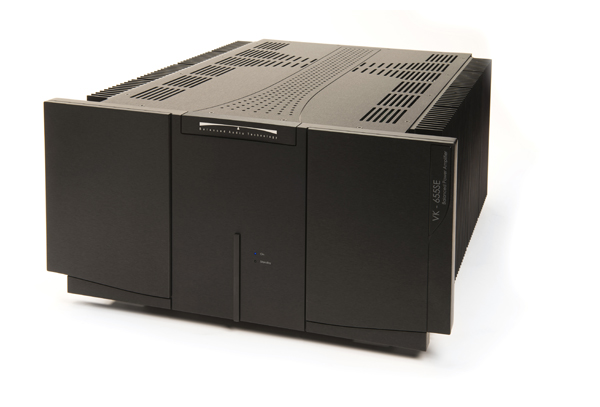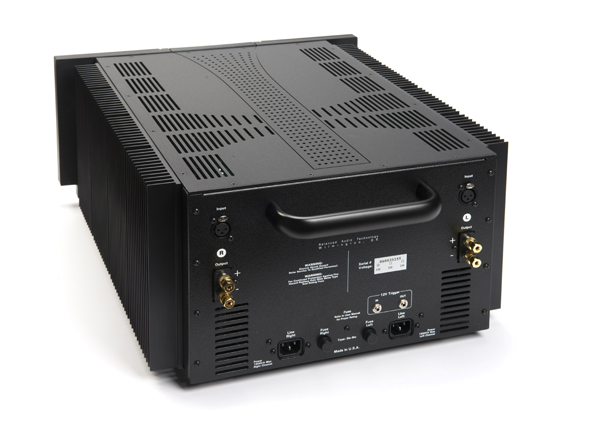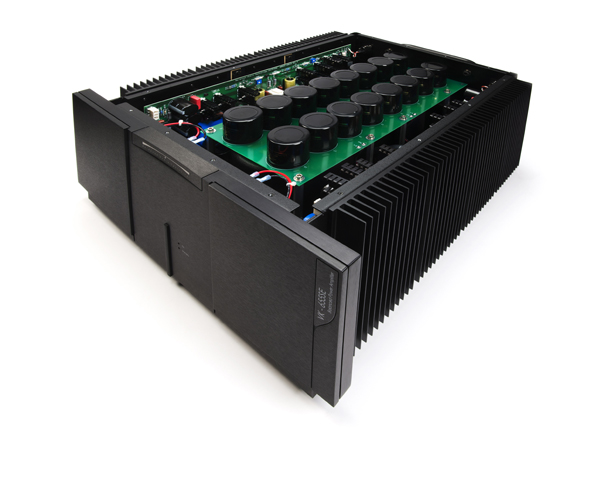Balanced Audio Technology VK-655SE King of Current
By Jeff Dorgay The only promise that BAT’s VK-655SE does not fulfill is the company’s claim that it has enough energy storage to “to lift most speakers over one meter off the ground.” Even at earsplitting levels, neither the 610-pound GamuT S9 nor the 253-pound Dynaudio Evidence Platinum speakers move ever so slightly off the ground.
The only promise that BAT’s VK-655SE does not fulfill is the company’s claim that it has enough energy storage to “to lift most speakers over one meter off the ground.” Even at earsplitting levels, neither the 610-pound GamuT S9 nor the 253-pound Dynaudio Evidence Platinum speakers move ever so slightly off the ground.
What the VK-655SE does deliver is musical accuracy, exquisite tonality and bass control. With 1,800 joules of power available, the $16,500 VK-655SE controls the lower half of the frequency spectrum in a way that precious few amplifiers can muster at any price. For the non-electrical engineers in the audience, a heart defibrillator uses between 200 and 400 joules at its maximum setting, so while the VK-655SE won’t lift your speakers off the ground, if you connect your speaker cables to your chest and crank it up, it will probably lift you a meter off the ground. Maybe that’s what they meant.
Speaking of weight, the VK-655SE weighs 120 pounds, so make sure your back and whatever stand you plan to place it on can withstand that much heft. Popping the lid reveals a pair of monstrous heat sinks, power transformers and capacitor banks. The VK-655 is available in all black (as shown here) or with a black-and-silver aluminum faceplate. In the future, BAT will also offer all silver, so if that is the aesthetic you desire, its on the way. Fully intended for use in an all-BAT system, the VK-655SE offers only balanced XLR inputs—though we found that the VK-655SE works equally well with Pass, ARC, Nagra, Simaudio and Robert Koda preamplifiers; all were used in a fully balanced configuration.
Let’s Roll
The VK-655SE is special straight out of the packing carton. Taking the hot-rodders credo, “If you want it to run hard, you have to break it in hard,” I immediately reach for Metallica’s album Kill ’Em All and play “No Remorse” at near-Armageddon levels. Even during a brief stint of driving the Dynaudios to almost 120 dB peaks, the BAT doesn’t strain whatsoever, with the raw power of Metallica thoroughly communicated. While I can’t imagine needing more power, you can turn the VK-655SE into a monoblock amplifier and get a bit more, going from 600 watts per channel into a 4-ohm load to 700 watts per channel. (The VK-655SE produces 300 watts per channel into an 8-ohm load as a stereo amp, and 400 watts as a monoblock.)
For those scoffing at the idea of paying twice as much for only 100 more watts per channel should remember that higher fidelity means gaining control, not just getting louder. This is because doing so doubles the current output, giving the monoblocks the ability to control difficult loads more effortlessly. Having twice as much power on tap will make those monos run even more effortlessly than running them in a stereo configuration, translating into greater dynamic range and an even quieter background – 6db according to BAT. I notice a similar effect going from a single Burmester 911 MK3 power amplifier to a pair of 911 monos. It is not subtle. I’ll stick my neck out and suggest a pair of mono VK-655SEs will achieve the same results.
Experience with BAT’s past products featuring the Super Pak upgrade (the company’s own variety of oil-filled capacitors to help facilitate all this power storage) showed that these components take a while to sound their absolute best—anywhere from two to 500 hours. The higher current flow of large power amplifiers makes the process a somewhat speedier one; the preamplifiers seem to take longer.
Slightly edgy at initial turn-on, the VK-655SE sounds more open, natural and relaxed in the upper register after about 48 hours of constant play, with a subtle smoothing as the hours rack up, but not as dramatic as the change during the first couple days. For the crabby audiophiles in the crowd who do not believe in component break-in, I highly suggest borrowing a pair of identical amplifiers, running one for a few hundred hours while you leave one in the box for that period of time and then compare the two. There is an unmistakable difference between the amplifier with hours on the clock and the one left in the box.
BAT’s Geoff Poore makes it a point to stress that they strive for “dynamic linearity” in their designs. A big part of this comes from their eliminating negative feedback in combination with an unlimited, unregulated power supply – adding to the jump factor that BAT amplifiers are famous for. It’s also one of the main reasons this huge amplifier exhibits the dexterity of a much smaller amplifier. Poore reminds me that “using only two gain stages in the VK-655SE eliminates coupling effects between multiple gain stages, further reducing the amount of image smear and degradation that comes with a more complex design.”
Where some power amplifier manufacturers claim a dual-mono design, BAT takes it to the extreme. In addition to separate power transformers and power supplies for each channel, the VK-655SE even uses separate power cords and receptacles for each channel! Should you have access to dedicated power lines, I suggest trying separate power lines on separate circuits for each channel. My curiosity with the VK-655SE is satisfied plugging each channel into separate 20-amp circuits. Of course, you don’t need two power lines for the VK-655SE, but with two separate mains fueling the fire at ear-splitting levels, the amp exhibits even more ease. About 95% of the time, you’ll never notice it, but if you really like it loud, go for separate AC circuits to power each half of your VK-655SE.
A Quick Comparison
If you believe all amplifiers have the same sound, stop reading now. Though the world’s top solid-state amplifiers are starting to sound more similar than disparate, differences in sonic character still exist. Side-by-side comparisons to a few of our regular amps reveal the BAT to excel in speed, dynamics and bass weight. The Burmester and Pass amplifiers in our stable are slightly warmer tonally, while the big Simaudio MOON 880M monos sound as natural as the BAT, but more bottomless in power capability—albeit at a higher price than a pair of VK-655SEs. It’s almost like comparing an Audi to a BMW or a Mercedes; all are excellent, though they go about delivering the goods in a slightly different way.
None of the speakers we have on hand present a challenging load to the mighty BAT. The current-hungry Magnepans and even our vintage Acoustat 2+2s, which have only an 82 dB sensitivity rating and are not much more than giant capacitors placed across the speaker terminals, do not diminish the amp’s performance in the least. Where some amplifiers can be speaker-dependent and struggle at times, the VK-655SE effortlessly powers every speaker we have on hand with ease.
Part of the neutral sound quality of the VK-655SE can be attributed to its use of all N-channel MOSFET output transistors. The N-channel MOSFET has a higher electron mobility, which makes amplifiers with them appear to have more transient speed than amps with mixed devices. Cursory research on the N-channel MOSFET implies that the N-channel device also has a wider range of operation where it acts like a triode tube—another great thing to have in a power amplifier. Techie bits aside, this amp succeeds brilliantly, especially for $16,500.
Bigger Is, Well, Bigger!
Some arguments in audiophile circles—about the quality of the first watt and that, because of their inherent complexity, higher-powered amplifiers are not as pure as low-power amplifiers in design and thus sound—don’t always hold true. Those arguments certainly don’t hold true in the case of this amplifier. While I’ve heard excellent examples of both low- and high-powered amps, I still tend to prefer the effortlessness of a high-powered one, even at low volumes. The VK-655SE takes a novel approach, featuring no negative feedback and only two gain stages in the entire circuit. In the same way that some large speakers manage to disappear in your listening room like a mini monitor, the VK-655SE has the sheer might of a large amplifier and the nuance of a small power amplifier.
Listening to acoustic instruments highlights the character of the VK-655SE. Its enormous power reserves might not be noticed with less-demanding fare, but the instant a drumstick hits a cymbal or the string of a standup bass is plucked with force, the boundless reserves of this amplifier deliver the dynamic swing required to convince your auditory system that perhaps you’re not listening to recorded music at all.
This is equally true when reproducing a vocalist with a wide range. Whether it’s your favorite opera or Prince, the VK-655SE’s instant delivery comes through free from the stress associated with lesser amplifiers unable to keep up—and this ability is too often overlooked when jumping on the low-power bandwagon. Simple as it might seem, a big, well-executed amplifier just sounds bigger and has a lack of restraint that further contributes to its overall neutral character.
There was nothing that the VK-655SE couldn’t handle effortlessly during this review. In the realm of the reference speakers at my disposal—all with sensitivity ratings of 87 to 90 dB—I can’t imagine ever needing more power than this amplifier delivers. BAT gear is known for its fantastic build quality and excellent secondary-market value, so for an amp at this size and price, I also can’t imagine ever needing another one once you’ve stepped up to the VK-655SE. Unless of course you need a second one.
BAT VK-655SE power amplifier
MSRP: $16,500
PERIPHERALS
| Analog Source | AVID Acutus Reference SP turntable TriPlanar tonearm Lyra Atlas cartridge |
| Phonostage | ARC REF Phono 2SE |
| Preamplifiers | Robert Koda K-10 ARC REF5 SE Pass Labs Xs |
| Digital Source | dCS Pagaini Stack Simaudio MOON 650D |
| Cable | Cardas Clear |
| Power | IsoTek Super Titan |





